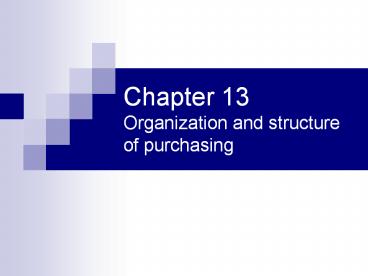Chapter 13 Organization and structure of purchasing - PowerPoint PPT Presentation
1 / 19
Title:
Chapter 13 Organization and structure of purchasing
Description:
Chapter 13 Organization and structure of purchasing Program Purchasing organization structure Influencing factors of position of purchasing Levels of tasks ... – PowerPoint PPT presentation
Number of Views:401
Avg rating:3.0/5.0
Title: Chapter 13 Organization and structure of purchasing
1
Chapter 13Organization and structure of
purchasing
2
Program
- Purchasing organization structure
- Influencing factors of position of purchasing
- Levels of tasks, responsibilities and authority
- Organizational structures within purchasing
- Purchasing job profiles
3
Purchasing organization structure
- Strongly depends on business characteristics and
situational factors - Level of centralized or decentralized structure
- Centralized
- Centralized hybrid
- Hybrid
- Decentralized hybrid
- Decentralized
- Usually a mixed organizational form is chosen
4
CPO reporting line
Johnson and Leenders (2004)
5
Supply organizational structure
Johnson and Leenders (2004)
These figures show that over the past decades
purchasing has become much more visible a the top
floor of large corporations
6
Factors influencing location of purchasing
- The organizational location of purchasing is very
much dependent on the view management holds
towards the purchasing function. - Management view is related to the following
factors - Purchasings share in the end-products cost
price - Financial position of the company
- Extent to which the company is depending on the
supply market
7
Tasks, responsibilities and authorities
- Strategic purchasing decisions (long term impact)
- Development and issuing operational guidelines,
procedures and task descriptions, which provide
authority to the purchasing department - Development and implementation of auditing and
review programs - Outsourcing of activities and/or functions
- Establishing long term contracts with preferred
suppliers - Adopting a supplier strategy based on multi-
versus single sourcing - Major investments
- Deciding on financial participation in suppliers
(backward integration) - Formulating policies concerning transfer pricing
and intercompany supplies - Formulating policies on reciprocal arrangements,
countertrade, etc.
8
Tasks, responsibilities and authorities
- Tactical purchasing decisions (medium term
impact) - Agreement on corporate and/or annual supplier
agreements - Preparing and developing value analysis programs
- Adopting and conducting quality certification
programs for suppliers - Selection and contracting of suppliers in general
- Programs aimed at supply-base reduction
- Operational purchasing decisions (short term
impact) - Ordering process
- Expediting activities related to released orders
- Invoice verification and payment
- Troubleshooting
- Monitoring and evaluation of supplier performance
9
Tasks, responsibilities and authorities
- Relationship between the three managerial levels
and some management positions
Managerial level
Top management
Logistics manager
Purchasing manager.
Senior buyer
Buying assistant
Strategic level X X X Tactical
level X X X Operational level X X
10
Organizational structures within purchasing
- Structures for multi-unit companies
- Decentralized purchasing BU purchasing is
responsible for all purchasing decisions - Centralized purchasing central purchasing
department is responsible for all strategic and
tactical purchasing decisions - Line/staff organization both corporate
purchasing and BU purchasing exist next to each
other and divide responsibilities and activities - Hybrid structure combination of the previous
three structures aimed at combining common
requirements across operating units. There are
different forms of pooling Voluntary
coordination, Lead buyership and Lead design
concept. - Cross-functional sourcing teams contracting is
done centrally by a commodity team. However, all
operational purchasing activities are
decentralized.
11
Organizational structures within purchasing
- Centralized versus decentralized purchasing some
criteria - to consider
- Commonality of purchasing requirements
- Geographic location
- Supply market structure
- Savings potential
- Expertise required
- Price fluctuations
- Customer demands
In practice these considerations appear to be
decisive when deciding on buying products
centrally or otherwise.
12
Organizational structures within purchasing
Centralized purchasing organizational structure
(example)
13
Organizational structures within purchasing
Decentralized purchasing organizational structure
(example)
14
Organizational structures within purchasing
Advantages and disadvantages of decentralised
purchasing
- Advantages
- Direct responsibility of operating companies
- Stronger customer orientation towards internal
user - Less bureaucratic purchasing procedures/higher
operational flexibility - Less friction costs due to coordination
- Direct communication with suppliers
- Disadvantages
- Dispersed purchasing power, lack of economies of
scale - No uniform way of handling towards suppliers
- Scattered supply market research
- Limited possibilities for building up specific
expertise on purchasing, supply markets and
components - Different commercial purchasing conditions among
different operating companies
15
Organizational structures within purchasing
Centralized/decentralized purchasing
organizational structure (example)
16
Organizational structures within purchasing
Cross functional sourcing teams at IBM
Van Weele and Rozemeijer (1996)
17
Consequences for purchasing professionals
18
Consequences for purchasing professionals
- Compared with ten years ago, purchasing
professionals are - Higher educated (business degree, MBA)
- Responsible for more dollars
- More likely to be a women
- Negotiating more long term agreements
- Involved in outsourcing decisions
- Looking out on a global market shape
- Reducing costs and the number of suppliers
19
Conclusions
- Purchasing structures appear to vary to a great
extent among companies. This is due to the
different views which top-managers hold towards
purchasing and supply. - When analysing the scope, tasks, responsibilities
and authority of the purchasing function, we
differentiated between the strategic level, the
tactical level and the operational level. - Purchasing structures appear to be highly
volatile a period of centralized purchasing is
often followed by a change to the other way
around.































